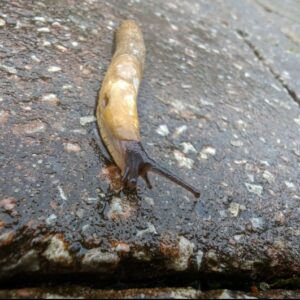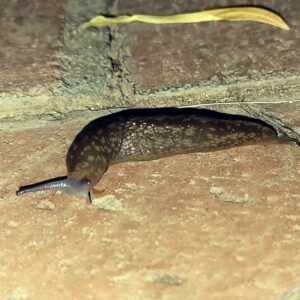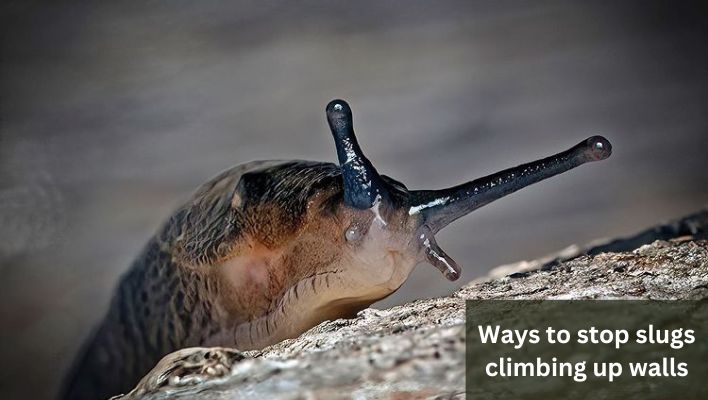Are you tired of slug-munching on the garden wall? You can bring them down with some slug annihilator. They are one of the most common pest problems in gardens, and we understand how frustrating it is when these pesky creatures destroy your vegetables.
Many people enjoy gardening, but not everyone is fond of the slugs that come with it. When slugs climb up walls, you find they are most commonly after your prize tomatoes, wisteria, and sunflowers. If you have ever encountered this situation, you will be aware of the awful state of your garden.
Slugs like to live on plants and other moist areas. They are nocturnal creatures, so you’ll find many of them late at night or early morning hours.
When this happens, if you don’t get these slugs under control soon, the whole garden will be covered in slime. Slugs can climb through cracks, holes, and even up drainpipes. The first step is to understand why they are attracted to your wall and eliminate the source of their attraction.
Slugs can also climb plants to eat plants. You can stop them with these methods if you find them doing this. However, one of the best ways to control them is to keep them out of your home in the first place using the methods listed below. This article will help you keep your walls clean from pesky mollusks.
If you’re looking for repellents, check out our page on protecting your plants from Slugs, which includes a list of expert recommendations.
Why Slugs are climbing up Your Walls
The first thing to know is that slugs do not only crawl on surfaces but also climb them. They were able to climb because they had a special kind of slime that sticks to surfaces, including glass windows, walls, fences, and even furniture. This slime helps them cling onto items so they can move more easily.
However, slugs are climbing up your walls because they’re looking for a way out or what to eat. The slugs you’re seeing might have hitched a ride on something like pet food or a leaf and then climbed up to the top of your wall so that they could find the best route out of your home. Below are some of the reasons slugs are climbing up your walls
- Slugs are looking for a place to lay their eggs. When they do this, it’s called “slugging.”
- They are trying to get away from predators.
- They climb up your walls because they’re hungry and looking for food.
- Slugs are climbing up your walls because of the moisture. They will only climb when enough moisture is available to get a good grip on a surface.
- They are climbing up your walls to find a way out.

What to Do When Slugs Are on the Wall
If you’ve noticed a slug or two wriggling its way across your wall, it’s time to take action. First and foremost, keep in mind that slugs are a natural part of life, and you’ll be able to get rid of them without using harmful chemicals.
Slugs climbing up walls is a common problem for homeowners, especially those with gardens. They are very good climbers, so you will be surprised how many slugs can climb up walls.
Getting rid of them is challenging, and they are destructive creatures that ruin your garden, lawns, and even your flower beds unless you get rid of them quickly.
Slugs and snails are quite good at finding their way around, which is why they’re so common in gardens. But if you see a few of them hanging out on your house or fence, it might be time to do something about it.
Slugs will often try to get in or escape through cracks or holes in the foundations of houses, so it’s important to seal any openings you discover.
You can also use anti-slug glue around the baseboards and joists of your house to prevent slugs from entering through those areas.
How to stop slugs climbing up walls
Below are the various ways to get rid of slugs and snails that are climbing your walls
Keep your garden well-maintained.
If you have a garden, keep it well-maintained. It will be much easier to control the slugs and snails if you can identify where they are coming from. If there’s not enough food for the slugs and snails, they will likely leave your home.
Also, ensure that plants or flowers in your yard aren’t infested with these pests. If they are, the slugs and snails will climb up into them and then try to move on to new homes.
Lastly, keep your compost heap in good shape. If you have a compost heap, add more compost or other organic material every few weeks to keep it working properly and make it harder for snails and slugs to climb over it.
Use slug pellets
Slug pallets are made from calcium carbonate, so they can help you solve the problem without resorting to pesticides or other chemicals. Slug pellets are made of a substance that attracts slugs and snails, which then die when they try to eat them.


These pallets can be purchased at most home improvement stores or online. These pallets can be sprinkled around the base of your fence to keep which slugs will eat and die while trying to climb your wall.
This is a great option because they can be placed anywhere around your yard or garden without harming anything else. However, there are reports of some slug pallets harming pets, so you must be careful when buying your ideal pallets. These pallets have been proven safe around pets and wildlife and are very effective at killing slugs within a few days.
Use diatomaceous earth
Slugs can be controlled by diatomaceous earth (DE), an all-natural substance that kills slugs on contact. It works by dehydrating the slug, so they die within a few hours of contact with DE. You can purchase DE at most garden stores or online.
Generally, to use DE, you need to sprinkle them around the base of your walls to prevent them from climbing; when they crawl over it, the substance cuts through their skin, and they will die from dehydration.
You will find more information on how to use this on its package, so you know how much is right for your garden or area.
Pour salt on them
Pouring salt on slugs and snails can be a great way to eliminate them. Just make sure you don’t pour it on any plants or flowers. Also, sprinkle salts around the base of your fence to keep slugs away; this can keep them away for more than a week, only if they are washed away by water or rain.
It’s also important not to pour it where your pets might come in contact with it, as the salt can injure them. You can use Epsom salt in place of regular slugs.
Alternatively, You can also try a combination of water and vinegar, which will kill off the pests. You should also make sure that you clean up any spills immediately with a mop or paper towels so that no one else gets hurt.

Use a bait station
A bait station will lure the slug inside with something tasty and trap it until it dies. You can purchase some of them online if you don’t feel like making them yourself. You can make a bait station out of an empty coffee or soda can and attach a small piece of string to the top.
Place it where slugs tend to congregate, like under rocks or logs. Keep the bait station there for about a week, and watch how quickly slugs population reduces in your garden.
Use garlic and mint tea.
Slugs hate the smell of garlic and mint, so using what they hate to keep them away is a great way to get rid of those pests without the hassle of chemicals or other methods. And the best part, It’s super easy to do.
Sprinkle garlic or mint tea oil or spray around the walls close to your garden or walls slugs like to climb to prevent them from climbing. The downside of this method is that once the smell fades, this method becomes impotent. With this, you need to apply garlic oil or mint tea frequently to keep slugs from climbing your walls.
Use nematodes
Nematodes are microscopic worms that kill slugs on contact by eating their internal organs until they die from eating them inside out.
Nematodes are microscopic worms that eat slugs and snails by feasting on their flesh. They can be purchased online or at garden supply stores like Home Depot and Lowes. They’re easy to use: mix them into the soil where you want the pests to go, then let nature take its course.
Install a barrier
A barrier is basically anything that prevents slugs and snails from climbing up onto your walls. It can be anything from a layer of mud to an entire wall made of rocks or bricks. Just make sure it’s something that prevents slugs and snails from climbing up onto the surface of your walls or prevents them from getting into your house in general.
There are two types of barriers: physical barriers that prevent slugs and snails from crossing them and chemical barriers that kill them on contact. The best way to choose which type of barrier is right for you is to test them both in different areas of your yard and see which ones work best.
Use barriers like gravel, crushed shells, or sharp sand around the base of walls. These surfaces are difficult for slugs to crawl over.
Chemical barriers kill slugs and snails in contact with their toxic chemical formulations, so there’s no need for messy cleanup afterward; make sure the chemical won’t harm pets or children.
Use copper wire to trap slugs.
Copper wire is a natural substance that has been used for thousands of years to trap pests. It’s cheap and easy to find in most hardware stores, and it’s also reusable.
You can use it to wrap around your garden fence or even wrap around the base of plants in your potting soil. Make sure you don’t wrap too tight because you don’t want the slug or snail to suffocate. You can also use copper tape for this purpose.
Slug-Repelling Plants:
Certain plants are known to repel slugs due to their strong scents or textures. These include:
- Rosemary: Slugs dislike the strong scent of rosemary and tend to avoid it.
- Mint: Mint plants emit a strong odor that can deter slugs.
- Lavender: Lavender’s fragrance can repel slugs and other pests.
- Sage: Sage leaves are often avoided by slugs.
Plant these slug-repelling plants near the walls or in areas where slugs are a problem to help deter them.
Beer Traps:
Beer traps are a popular way to attract and drown slugs. Here’s how to set up a beer trap:
- Bury a shallow container, like a small dish or jar lid, in the ground near the walls so that its rim is at ground level.
- Fill the container with beer (slugs are attracted to the yeast in beer).
- Slugs will be lured into the container, fall in, and drown.
Check the traps regularly and refill them as needed.
Use Natural Predators:
Encouraging natural predators in your garden can be an effective way to control slug populations. These predators include:
- Birds: Birds like thrushes, blackbirds, and ducks are known to feed on slugs.
- Frogs and Toads: These amphibians are voracious slug eaters and can help keep slug populations in check.
- Ground Beetles: Certain ground beetle species are known to prey on slugs and other pests.
To attract these predators, create a welcoming habitat by providing water sources, and shelter, and minimizing the use of chemical pesticides.
Reduce Mulch:
Mulch can provide hiding spots for slugs, so reducing the thickness of mulch or using slug-resistant mulch can help deter them. Opt for materials like crushed stone, gravel, or cocoa bean shells that slugs are less likely to hide under. Keep mulch a few inches away from the wall’s base to create a barrier.
Remember that a combination of these methods may be more effective than using just one. Also, consistently maintaining your garden and employing preventive measures can help keep slug problems under control.
Get rid of slug trails on your walls with this detailed guide to restore the beauty of your walls. Although these trails are harmless, they can be unsightly.
Is pouring salt on a slug cruel?
Pouring salt on something is not cruel if it is done to provide a needed service. In fact, it’s very often the case that this method of treating something is used to provide the service.
When you pour salt on a slug, you’re adding a substance that will make the slug shrink and die. It’s not cruel to do that to a slug. It’s just how they respond to their environment. If they aren’t getting enough water or nutrients, they’ll go into a state of shock and die. Salt is just like that!
Let’s say you want to get rid of slugs. You could just pick up some salt and sprinkle it around outside where you find them, or you could pour some salt into a jar and bring it inside with you so that when they come in contact with the salt, they’ll die.
The first option would be cruel because when someone sees you doing it, they might feel bad for your poor pet snail. The second option will help solve your problem without causing any distress or discomfort to anyone else.
